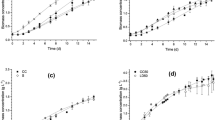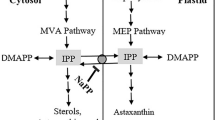Abstract
This study aimed to analyze the effect of magnetic field (MF) application on the metabolism of Synechococcus elongatus PCC 7942. Concentrations of biomass, carbohydrate, protein, lipid, and photosynthetic pigments (chlorophyll-a, C-phycocyanin, allophycocyanin and phycoerythrin) were determined. In cultures with MF application (30 mT for 24 h d−1), there were increases of 47.5% in total protein content, 87.4% in C-phycocyanin, and 332.8% in allophycocyanin contents, by comparison with the control. Allophycocyanin is the most affected pigment by MF application. Therefore, its biosynthetic route was investigated, and four genes related to its synthesis were found. However, the analysis of the gene expression showed no statistical differences from the control culture, which suggests that induction of such genes may occur soon after MF application with consequent stabilization over time. MF application may be a cost-effective alternative to increase production of compounds of commercial interest by cyanobacteria.
Graphical Abstract




Similar content being viewed by others
Data Availability
Not applicable.
Code Availability
Not applicable.
References
Bezerra PQM, Moraes L, Cardoso LG, Druzian JI, Morais MG, Nunes IL, Costa JAV (2020) Spirulina sp. LEB 18 cultivation in seawater and reduced nutrients: bioprocess strategy for increasing carbohydrates in biomass. Bioresour Technol 316:123883
Satyanarayana KG, Mariano AB, Vargas JVC (2011) A review on microalgae, a versatile source for sustainable energy and materials. Int J Energy Res 35:291–311
Ducat DC, Sachdeva G, Silver PA (2011) Rewiring hydrogenase-dependent redox circuits in cyanobacteria. Proc Natl Acad Sci USA 108(10):3941–3946
Ludwig M, Bryant DA (2011) Transcription profiling of the model cyanobacterium Synechococcus sp. strain PCC 7002 by next-gen (SOLiDTM) sequencing of cDNA. Front. Microbiol 2(41):1–23
Deamici KM, Santos LO, Costa JAV (2021) Magnetic field as promoter of growth in outdoor and indoor assays of Chlorella fusca. Bioprocess Biosyst Eng 44:1453–1460
Costa SS, Peres BP, Machado BR, Costa JAV, Santos LO (2020) Increased lipid synthesis in the culture of Chlorella homosphaera with magnetic fields application. Bioresour Technol 315:123880
Silva PGP, Prescendo Júnior D, Sala L, Burkert JFM, Santos LO (2020) Magnetic field as a trigger of carotenoid production by Phaffia rhodozyma. Process Biochem 98:131–138
Repacholi MH, Greenebaum B (1999) Interaction of static and extremely low frequency electric and magnetic fields with living systems: health effects and research needs. Bioelectromagnetics 20:133–160
Ruiz-Dominguez MC, Jáuregui M, MedinaJaime EC, Cerezal Mezquita P (2019) Rapid green extractions of C-Phycocyanin from Arthrospira maxima for functional applications. Appl Sci 9:1–13
Ilter I, Akyıl S, Demirel Z, Koç M, Conk-Dalay M, Kaymak-Ertekin F (2018) Optimization of phycocyanin extraction from Spirulina platensis using different techniques. J Food Compos Anal 70:78–88
Khatoon H, Kok Leong L, Abdu Rahman N, Mian S, Begum H, Banerjee S, Endut A (2018) Effects of different light source and media on growth and production of phycobiliprotein from freshwater cyanobacteria. Bioresour Technol 249:652–658
Rippka R, Deruelles J, Waterbury JW, Herdman M, Stanier RG (1979) Genetic assignments, strain histories and properties of pure cultures of Cyanobacteria. J Gen Microbiol 111:1–61
Hendry JI, Prasannan CB, Joshi A, Dasgupta S, Wangikar PP (2016) Metabolic model of Synechococcus sp. PCC 7002: prediction of flux distribution and network modification for enhanced biofuel production. Bioresour Technol 213:190–197
Dubois M, Gilles KA, Hamilton JK, Rebers PA, Smith F (1956) Colorimetric method for determination of sugars and related substances. Anal Chem 28:350–356
Lowry OH, Rosebrough NJ, Farr AL, Randal RJ (1951) Protein measurement with the Folin phenol reagent. J Biol Chem 193:265–275
Marsh JB, Weinstein DB (1966) Simple charring method for determination of lipids. J Lipid Res 7:574–576
Lichtenthaler HK (1987) Chlorophylls and carotenoids: pigments of photosynthetic biomembranes. Methods Enzymol 148:350–382
Ores JC, Amarante MCA, Kalil SJ (2016) Co-production of carbonic anhydrase and phycobiliproteins by Spirulina sp. and Synechococcus nidulans. Bioresour Technol 219:219–227
Bennett A, Bogorad L (1973) Complementary chromatic adaptation in a filamentous blue-green-alga. J Cell Biol 58:419–435
Bailey JE, Ollis DF (1986) Biochemical Engineering Fundamentals. 2ª ed. McGrawHill, Singapore, pp 397–398.
Pinto F, Pacheco CC, Ferreira D, Moradas-Ferreira P, Tamagnini P (2012) Selection of suitable reference genes for RT-qPCR analyses in cyanobacteria. PLoS ONE 7:e34983
Livak KJ, Schmittgen TD (2001) Analysis of relative gene expression data using real-time quantitative PCR and the 2(-Delta Delta C(T)) Method. Methods 25:402–408
Bauer LM, Costa JAV, Da Rosa APC, Santos LO (2017) Growth stimulation and synthesis of lipids, pigments and antioxidants with magnetic fields in Chlorella kessleri cultivations. Bioresour Technol 244:1425–1432
Deamici KM, Cardias BB, Costa JAV, Santos LO (2016) Static magnetic fields in culture of Chlorella fusca: Bioeffects on growth and biomass composition. Process Biochem 51:912–916
Ducret A, Müller SA, Goldie KN, Hefti A, Sidler WA, Zuber H, Engel A (1998) Reconstitution, characterization and mass analysis of the pentacylindrical allophycocyanin core complex from the cyanobacterium Anabaena sp. PCC 7120. J Mol Biol 278:369–388
Sun L, Wang S (2003) Allophycocyanin complexes from the phycobilisome of a thermophilic blue-green alga Myxosarcina concinna Printz. J Photochem Photobiol B 72:45–53
Deamici KM, Santos LO, Costa JAV (2019) Use of static magnetic fields to increase CO2 biofixation by the microalga Chlorella fusca. Bioresour Technol 276:103–109
Wang HY, Zeng XB, Gui SY, Li ZT (2008) Effects of magnetic field on the antioxidant defense system of recirculation-cultured Chlorella vulgaris. Bioelectromagnetics 29:39–46
Gao W, Liu Y, Zhou J, Pan H (2005) Effects of a strong static magnetic field on bacterium Shewanella oneidensis: an assessment by using whole genome microarray. Bioelectromagnetics 26:558–563
Veiga MC, Fontoura MM, Oliveira MG, Costa JAV, Santos LO (2020) Magnetic felds: biomass potential of Spirulina sp. for food supplement. Bioprocess Biosyst Eng 43:1231–1240
Li Z, Guo S, Li L, Cai M (2007) Effects of electromagnetic field on the batch cultivation and nutritional composition of Spirulina platensis in an air-lift photobioreactor. Bioresour Technol 98:700–705
Deamici KM, Costa JAV, Santos LO (2016) Magnetic fields as triggers of microalga growth: evaluation of its effect on Spirulina sp. Bioresour Technol 220:62–67
Duarte JH, Costa JAV (2017) Synechococcus nidulans from a thermoelectric coal power plant as a potential CO2 mitigation in culture medium containing flue gas wastes. Bioresour Technol 241:21–24
Barsanti L, Gualtieri P (2006) Algae: Anatomy, Biochemistry, and Biotechnology. CRC Press - Taylor and Francis Group, Boca Raton
Noaman NH, Fattah A, Khaleafa M, Zaky SH (2004) Factors affecting antimicrobial activity of Synechococcus leopoliensis. Microbiol Res 159:395–402
Miller AG, Colman G (1980) Evidence for HCO3- transport by the blue green alga (cyanobacterium) Coccochloris penuicystis. Plant Physiol 65:397–402
Shiraiwa Y, Goyal A, Tolbert NE (1993) Alkalization of the medium by unicellular green algae during uptake of dissolved inorganic carbon. Plant Cell Physiol 34:649–657
Deamici KM, Cuellar-Bermudez SP, Muylaert K, Costa JAV, Santos LO (2019) Quantum yield alterations due to the static magnetic fields action on Arthrospira platensis SAG 21.99: evaluation of photosystem activity. Bioresour Technol 292:1–6
Snoussi S, El May AE, Coquet L, Chan P, Jouenne T, Landoulsi A, Dé E (2012) Adaptation of Salmonella enterica Hadar under static magnetic field: effects on outer membrane protein pattern. Proteome Sci 10:1–9
Menestrino BC, Pintos THC, Sala L, Costa JAV, Santos LO (2020) Application of static magnetic fields on the Mixotrophic culture of Chlorella minutissima for carbohydrate production. Appl Biochem Biotechnol 19:822–830
Deamici KM, Santos LO, Costa JAV (2018) Magnetic field action on outdoor and indoor cultures of Spirulina: evaluation of growth, medium consumption and protein profile. Bioresour Technol 249:168–174
Cherdkiatikul T, Suwanwong Y (2014) Production of the α and β Subunits of Spirulina Allophycocyanin and C-Phycocyanin in Escherichia coli: a comparative study of their antioxidant activities. J Biomol Screen 19:959–965
Aarholt E, Flinn EA, Smith CW (1982) Magnetic fields affect the lac operon system. Phys Med Biol 27:606–610
Santos LO, Silva PGP, Machado BR, Sala L, Deamici KM (2022) Update on the application of magnetic fields to microalgal cultures. World J Microbiol Biotechnol 38:211
MacColl R, Eisele LE, Menikh A (2003) Allophycocyanin: trimers, monomers, subunits, and homodimers. Biopolymers 72:352–365
MacColl R (1998) Cyanobacterial phycobilisomes. J Struct Biol 124:311–334
Adir N (2005) Elucidation of the molecular structures of components of the phycobilisome reconstructing a giant. Photosynth Res 85:15–32
Adir N, Dines M, Klartag M, McGregor A, Melamed-Frank M (2006) Assembly and disassembly of phycobilisomes. In: Shively JM (ed) Microbiology Monographs: Inclusions in Prokaryotes 2. Springer, Berlin Heidelberg, pp 47–77
Anderson LK, Toole CM (1998) A model for early events in the assembly pathway of cyanobacterial phycobilisomes. Mol Microbiol 30:467–474
McGregor A, Klartag M, David L, Adir N (2008) Allophycocyanin trimer stability and functionality are primarily due to polar enhanced hydrophobicity of the phycocyanobilin binding pocket. J Mol Biol 384:406–421
Acknowledgements
The authors are thankful for the financial support provided by the National Counsel for Technological and Scientific Development – Brazil (CNPq). L. F. Marins is a research fellow from Brazilian CNPq (Proc. 309634/2018-0). L. O. Santos is a research fellow from CNPq (Proc. 312486/2022-7).
Funding
The authors received support from National Counsel for Technological and Scientific Development–Brazil (CNPq) for the submitted work.
Author information
Authors and Affiliations
Contributions
RRCdN, MdRM, RdSA, JAVC, LFM, and LOdS: contributed to the study conception and design. Material preparation, data collection and analysis were performed by RRCdN, MdRM, and RdSA. The first draft of the manuscript was written by RRCdN and MdRM, and all authors commented on previous versions of the manuscript. All authors read and approved the final manuscript.
Corresponding author
Ethics declarations
Conflict of interest
The authors have no competing interests to declare that are relevant to the content of this article.
Ethical Approval
Not applicable.
Consent to Participate
Not applicable.
Consent for Publication
Not applicable.
Additional information
Publisher's Note
Springer Nature remains neutral with regard to jurisdictional claims in published maps and institutional affiliations.
Rights and permissions
Springer Nature or its licensor (e.g. a society or other partner) holds exclusive rights to this article under a publishing agreement with the author(s) or other rightsholder(s); author self-archiving of the accepted manuscript version of this article is solely governed by the terms of such publishing agreement and applicable law.
About this article
Cite this article
Nascimento, R.R.C., Moreno, M.R., Azevedo, R.S. et al. Magnetic Fields as Inducers of Phycobiliprotein Production by Synechococcus elongatus PCC 7942. Curr Microbiol 80, 242 (2023). https://doi.org/10.1007/s00284-023-03348-3
Received:
Accepted:
Published:
DOI: https://doi.org/10.1007/s00284-023-03348-3




